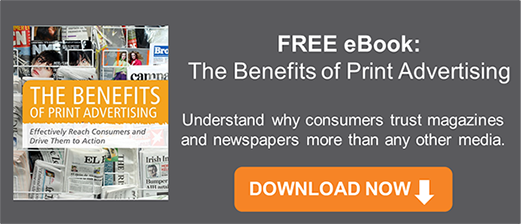As many companies abandon traditional marketing methods in a mad dash to embrace social media and online tactics, those advertisers in the know stick with what has always worked. While traditional channels may not suit every brand story or budget, many are still a great way to extend reach, engage consumers and increase the bottom line.
Consumers Prefer Traditional Advertising
Why is it that digital ad budgets get bigger and bigger and news of the decline of print ad revenues continues to make the rounds, yet many studies reveal that consumers are still far more likely to interact with and trust traditional channels?
According to an Adobe survey consumers continue to rely on word of mouth from family and friends (51%) as well as consumer forums (35%) to gain credible information on products and brands. These channels were closely followed by traditional media such as print ads and television with 28% of respondents referring to them, only 17% trusting websites, and a mere 8% looking to social media to gain brand awareness.
The same survey scored traditional media as the most effective (47%) and company websites as somewhat effective (18%).
 Another study by the Shullman Research Center found that traditional advertising channels such as print and television were the best bet for reaching affluent audiences. In fact, the survey clearly indicates that four out of the top five advertising channels for reaching millionaires (you know, those consumers who have money to burn) were traditional, with print ads receiving the highest level of interest (74%) from survey participants.
Another study by the Shullman Research Center found that traditional advertising channels such as print and television were the best bet for reaching affluent audiences. In fact, the survey clearly indicates that four out of the top five advertising channels for reaching millionaires (you know, those consumers who have money to burn) were traditional, with print ads receiving the highest level of interest (74%) from survey participants.
Which Traditional Advertising Channels Are Right for You?
Not all channels work with all offers and messages so it’s important to know your business as well as your target audience inside and out.
Newspapers and Magazines
Obviously the goal of any advertising campaign is to reach your target audience and you can easily determine what channels they prefer (in this case print vs. digital content) by studying print readership demographics and examining purchasing data.
You may find despite the many claims that print is dead, your particular audience still very much engages with newspapers. As we mentioned previously, this is especially true if your audience happens to be affluent, in which case it makes loads of sense to drop a good chunk of your ad budget into newspapers.
Magazines also have their advantages like offering advertising that has the ability to reach a highly targeted audience. This means you’ll be able to reach only those consumers who are likely to spend their dollars with you. If your product or service is highly specialized, then advertising in specialty magazines that cater to a very particular audience will likely increase your ROI.
Some things to remember when advertising in newspapers or magazines:
- Before purchasing any print ads, be sure to request a copy of the publication’s media kit so you can examine their current circulation numbers and readership demographics.
- Choose an ad size that makes sense for your budget. Contrary to what you may think, full page ads aren’t the only ones that make big impacts. Well-designed smaller ads can also be highly effective at sharing your message.
- You’ll want to study the publication’s schedule to place your ad effectively. By knowing your demographic and the publication schedule you can ensure your ad gets the highest traffic for your market.
- Many newspaper and magazine readers interact with both the print and online versions of the publication, so consider buying a robust advertising package that will place your ad both in the online and physical publications.
Television and Radio
Not all businesses have the budget to handle radio and TV campaigns, but if you do, these channels can perform beautifully and reach your local audience. Placing TV and radio ads calls for some real strategy and the ability to study demographics in order to choose TV shows and radio stations that already reach your market.
Some things to remember when advertising in radio or television:
- TV and radio ads have to be unique and creative in order to grab the viewer’s/listener’s attention in 30 seconds or less. Spend time really considering what your unique message is and how you can relay it in an engaging way.
- Mixing and matching air times can be a great way to stretch your ad spend. Sure prime time seems the logical choice to reach as many prospects as you can, but it also will cost a pretty penny. Better to mix and match high dollar and cheaper slots to gain the most reach for the best price.
Billboards
Billboards still have their place in a marketing mix and can communicate a brand’s message clearly and loudly. Billboard advertising works best for those messages that are simple and compelling and that need to reach a larger market in a specific geographical area.
Some things to remember when advertising with billboards:
- Bargains don’t always pay off. Yes, well-placed billboards may cost four times as much as ones placed in crappy locations, but they will get your message in front of your audience, whereas the cheaper placement may only get your message in front of pigeons and a garbage dump.
- Do you have something everyone needs? It’s hard to target drivers, which is why billboards work best when your offer is something everyone needs, like car insurance, a better night’s sleep, or good ol’ gasoline.
- On average most drivers will see your billboard for only two to three seconds, so this means your message has to get to the point. Make sure your design is clean and your images are engaging. You must have a big call to action. Also, your URLs or 800 numbers should be easy to memorize as drivers won’t be able to write them down.
The key to great advertising has always been and will always be identifying and understanding your particular market. Traditional channels can be highly effective at reaching certain demographics. The thing to remember is, it doesn’t have to be a one or the other situation. The best advertising strategies are robust and mix traditional channels with digital channels to ensure the greatest reach.
RELATED POSTS:





